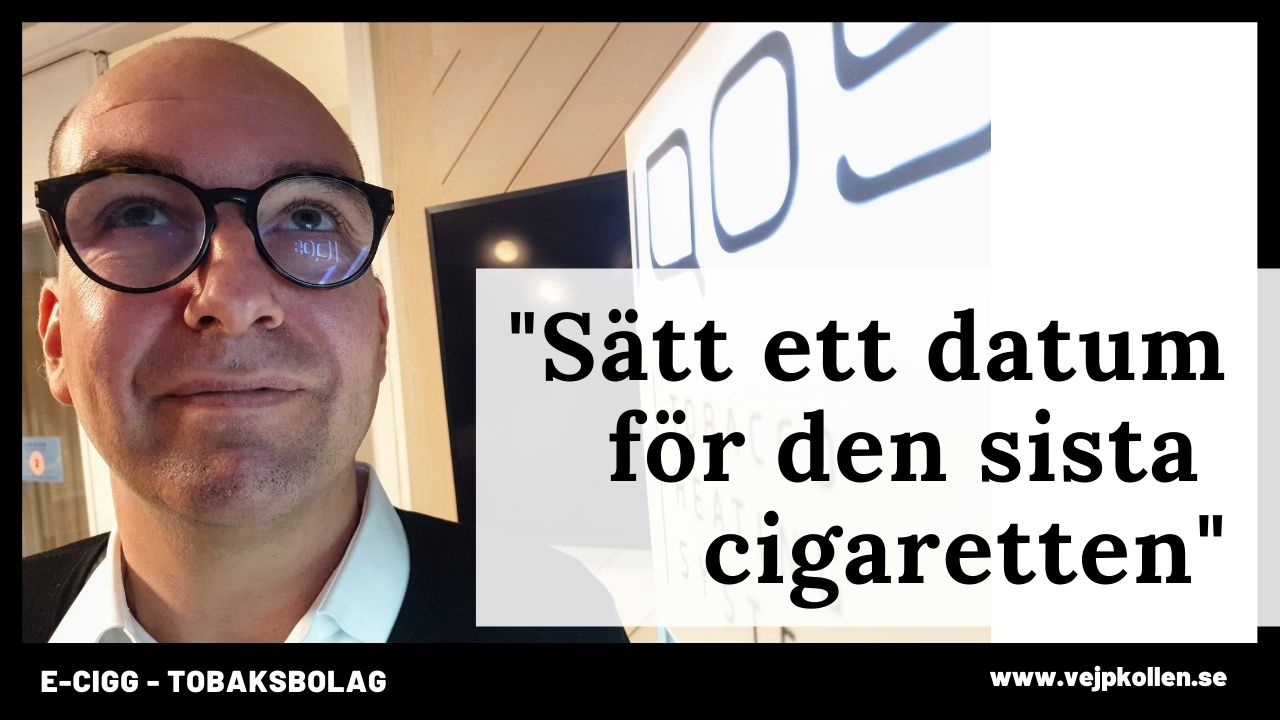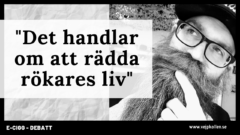The debate on harm minimisation and e-cigarettes is a heated one. Especially since tobacco companies got involved. But what do they really want? And why do cigarette manufacturers care about e-cigarettes? Vejpkollen visited Philip Morris.
The world of tobacco and harm reduction, especially e-cigarettes, is like a minefield. A playing field where every step risks triggering an explosion.
It is very difficult to get it right.
It is very easy to make mistakes.
I think about this as I stand in the lobby of Philip Morris - one of the world's largest tobacco companies. It's a pretty fancy office, but not as flashy as you'd expect from one of the world's biggest companies. A few armchairs, a table, a coffee machine sighing in the corner. Nothing excessive. Very quiet.
Something undesirable
In the centre of the room, however, stands one of the reasons why the debate on harm reduction and e-cigarettes is so complicated. A glass case containing Philip Morris' own version of a vaping product - IQOS - an electronic system for heating tobacco.
In all its simplicity, it is a product that reduces the risks of inhaling nicotine. But it is also a product that divides politicians, health researchers, activists and, for that matter, road users into several opposing camps. On the one hand, those who see all the piety of harm reduction as something welcome. On the other hand, those who see everything coming from a tobacco company as something undesirable.
The doctor who changed sides
I am here to meet Claude Guiron, Scientific Director for Philip Morris' Nordic operations. A cardiologist by training, coming directly from the pharmaceutical industry, he is now employed by PMI to deliver a specific message: a smoke-free society is possible, harm reduction works and tobacco companies have some of the solutions. IQOS, electronically heated tobacco, is one of them. Traditional e-cigarettes, snus and nicotine pouches are others.
"We have the technology today and several smoke-free products have developed rapidly in the last five years alone. PMI's goal is to become a smoke-free company, but to do that we need to get smokers to stop smoking. We also know that current smoking cessation medicines do not work for everyone. Many smokers want to continue using nicotine, so snus, nicotine pouches and e-cigarettes are important alternatives. " says Claude Guiron.
Called the Angel of Death
Claude Gurion is the doctor who changed sides. From medicine to tobacco. From saint to heretic. I don't know if the analogy is fair. But there is no doubt that others like to use biblical terms to describe Claude Guiron. He and Philip Morris were recently called "angel of death" by Aftonbladet columnist Peter Kadhammar. It is a strong expression that would normally be removed by any publisher. But not in the case of Claude Guiron and Philip Morris. It's gloves off. All messages from the tobacco industry are by definition dangerous. That includes anyone on their payroll.
Stigma
Claude Guiron is aware of that too. Dealing with it is part of his job description.
"Smoking is surrounded by a huge stigma. And tobacco companies don't have a good reputation, of course. You have to step back and think about why we are doing this in the first place? It's about offering smokers an acceptable alternative to cigarettes. And it's incredibly inspiring to be part of. It will take time to build trust, of course. But it makes the job meaningful too," says Claude Guiron.
Want to ban cigarettes
Phillip Morris attracted worldwide attention when CEO Jacek Olczak proposed that all cigarette sales in the UK should be cancelled. be banned within 10 years. A somewhat unexpected move by one of the world's leading cigarette companies. And quite problematic. Why would a company want to ban the product they make billions from?
The answer: Alternative products: e-cigarettes, nicotine pouches, snuff. And IQOS.
Harm reduction in politics
It was no coincidence that the PMI focused on the UK. Harm reduction is an integral part of UK tobacco policy and e-cigarettes have taken place as a cutting-edge technology to phase out smoking, alongside traditional medicines.
"E-cigarettes are not risk-free but significantly less harmful than cigarettes. Smokers should therefore consider switching to vaping." British health authorities repeat time and again in public statements.
Similar strategies are seen in the New Zealand and to some extent USA, where IQOS, was recently classified as a harm reduction product (Swedish snus has also received such a classification).
Set an expiry date for cigarettes
Claude Guiron argues that Swedish politicians should also consider the matter.
"Set a date. A time when the last cigarette is sold. Until then, raise taxes on analogue cigarettes and keep them low for alternatives. Allow less harmful products to become more attractive to smokers. Allow manufacturers to provide information on relative risks of harm. For smokers - not non-smokers"
Nicotine
Claude Guiron sounds like any harm reduction activist. It is about relative risksthat smokers should receive accurate information about the harmful effects of nicotine versus smoke. That a smoke-free life does not necessarily mean total abstinence from nicotine - that nicotine is not the enemy.
"We will help smokers to quit cigarettes in several ways. For smokers for whom medication and therapy do not work, there must be more alternatives," said Mr Guiron.
The enemy with a capital F
The difference, of course, is that Claude Guiron represents something different. He is not an old-fashioned roadside shop owners or a passionate ex-smoker puffing on an e-cig. He represents a major tobacco company. Big Tobacco. With all that entails.
For many, he is the enemy with a capital F.
Injury reduction - a new target
Since tobacco companies started using the word 'harm reduction', the term itself has become a target, almost more so than smoking itself. Activist groups such as Non Smoking Generation, Tobacco Facts - both funded by Public health authoritiescalls tobacco harm reduction a myth - a Trojan horse that could favour tobacco companies if we let the philosophy seep into policy.
Harm minimisation in other areas
At the same time harm minimisationIn drug and sexual policy - needle exchanges and condoms are examples of harm reduction. In traffic, we see bicycle helmets and seat belts - innovations that make risky behaviour less dangerous. No one seriously believes that we will stop cycling and driving just because it can lead to fatal accidents. Nor do young people stop having spontaneous sexual relations just because it can lead to unwanted pregnancies or STDs. Nor will all addicts stop using drugs just because it is 'best' not to. They have much to gain from clean needles and an open door to care and support.
Most people agree that harm minimisation can save lives.
A myth?
But this does not apply to smoking. At least not in Sweden.
"Tobacco harm reduction is a myth spread by the Tobacco Act. There is now better help available through medicines and support through the health service for those who want to stop smoking," said the Public Health Agency's head of unit. Josefin P. Jonsson during a seminar in Almedalen as late as 2021.
So who can you trust? Experts contradict each other, science is interpreted differently. It is easy to get it wrong, difficult to get it right. Both for smokers and politicians.
An established concept
Claude Guiron is convinced that there is no way to stop this development. E-cigarettes, nicotine vaping, basically an innovation that has grown from the grassroots level. But it is here to stay. At the same time, tobacco companies are not going away, they are adapting to a market where fewer people want to smoke. They are taking up space, if only through their enormous financial capacity. And to exclude them from the discussion on reducing the harm caused by smoking is naïve, he says.
"Harm reduction is a well-established concept in research that has proven to be an effective way to reduce the harm caused by a deadly product," says Claude Guiron. "It's not just us saying this. There is plenty of independent research and clear examples of harm minimisation working. Sweden is a good example, where alternatives like snus and nicotine pouches have been around for a long time. Here, smoking is down to 6 per cent. In the UK, where e-cigarettes have been introduced, smoking is declining rapidly. In Japan, where sales of heat-not-burn products are growing rapidly, smoking is declining even more."
Alternatives to cigarettes
Claude Guiron says that many companies and authorities around the world are looking at Sweden. "And it's not about our tough rules for tobacco products. It's about the fact that tobacco sells well here, while tobacco-related harm is relatively low.
"They see that it is not only restrictive legislation that works. In countries that do not allow alternatives, it turns out that smoking is much higher. Finland and Denmark, with stricter legislation on e-cigarettes and snus, has a higher proportion of smokers (14%) compared to Sweden and Norway"
Economic calculation in the background
Snus has been a key product, says Claude Guiron. It is a phenomenon that de-normalised smoking from the very beginning. The public health authorities and the anti-tobacco movement certainly do not agree with this analysis. But many tobacco companies, who base almost everything they do on economic realism, see opportunities to broaden their portfolio with less harmful products. That actually sells.
Want to reduce cigarette sales
PMI wants to be at the forefront of that development, of course. But competitors such as British American Tobacco and Japan Tobacco are on board, at least as motivated. In addition to IQOS, PMI has invested in snus, nicotine pouches and e-cigarettes. Some products are available on the Swedish market, others are not.
"Tobacco companies are not the fastest innovators in the world. What we are very good at is disseminating products for mass consumption through efficient distribution. We don't develop everything ourselves but also buy technology, develop it further and make it available globally. It doesn't really matter what type of product it is: cigarettes, e-cigarettes, snus or nicotine pouches. But there's always an economic calculation in the background, of course," says Claude Guiron. "Today, 30 per cent of PMI's revenue comes from smoke-free products. The goal is for everything to do so. But it's happening gradually, and by 2025 it will be 50 per cent. But all launches are preceded by an economic calculation. Will it be possible to sell the products?"
Tobacco industry stopped by the WHO
But selling requires more than just good arguments. Marketing of nicotine and tobacco products is currently severely restricted. This also applies to traditional lobbying and information about research results that would increase interest among smokers. But according to WHO Tobacco Convention of 2003, the tobacco industry should not be allowed to influence the health policies of the countries that have signed the Convention. So no matter what Phillip Morris, or any other tobacco company, says, they MUST by definition speak to deaf ears. So also in Sweden.
"It is of course very frustrating. The WHO statement comes from a different era" says Claude Guiron "A lot has happened since 2003. We have seen incredible innovation in products that deliver nicotine in a less harmful way. And authorities are struggling to keep up, partly because the Convention prevents communication with companies. We are the experts on the products we have developed. We also see this when we look at knowledge about smoking and harm reduction among smokers. It is very poor. The only thing we can do is to be more transparent, write debate articles and invite people to open lectures. But it's very skewed."
Smokers do not receive correct information
This bias is reflected in the information that reaches the target audience for harm reduction programmes, says Claude Guiron. Smokers. When the UK Public Health Agency in 2020 asked smokers what they know about e-cigarettes, it became clear that something is not right. Nearly half of all smokers thought that vaping, or e-cigarette use, was as or more harmful than smoking. The science, according to UK authorities, clearly shows that it is the opposite. Using a regulated e-cigarette means that smokers expose themselves to a significantly lower risk, almost 95 per cent lower.
"It is the smoke, the combustion that kills smokers. Knowledge of this is actually quite low, even among doctors and those who work with smoking cessation. Even worse, 30 per cent of smokers who have a heart attack continue to smoke afterwards. And nearly 40 per cent of patients with COPD continue to smoke, even though it aggravates the disease," says Claude Guiron.
IQOS - more research needed
IQOS also has a harm profile similar to traditional e-cigarettes. However, the British health authorities notes that the technology is much more recent and that much of the research on IQOS comes from Philip Morris.
"More independent research is needed. The use of IQOS is less harmful than cigarette smoking, but whether it is 95 per cent less dangerous, we strictly speaking do not know today" admits Claude Guiron.
"Faster if everyone pulls in the same direction"
But who really listens to the "angel of death"? Tobacco companies still make the most money from cigarette sales. And although smokeless products such as nicotine pouches and electronic cigarettes are growing at an ever-increasing rate, it is still smoking tobacco that is in greatest demand. But smokers are the key, says Mr Guiron. Their choices can change an entire industry, he says.
"We still have 500 000 daily smokers in Sweden. Many of them do not want to stop smoking. This is a large group that can be helped by new technologies, such as e-cigarettes or heat-not-burn products. The problem is that if we stop selling cigarettes, someone else will sell them instead. So it's not very likely that someone will stop selling cigarettes overnight. We need to change an entire industry. It's about phasing out smoking. Smoke-free products can take up more space little by little. PMI is investing heavily in change. But it would go faster if authorities and politicians worked in the same direction."
Flavourings - a source of concern
Back in the foyer. With IQOS, Claude Guiron and an unclear future. This spring, the Swedish Parliament will discuss harm reduction within the new strategy for alcohol, drugs, doping, tobacco and gambling (ANDTS). Later also a possible flavour ban for e-cigarettes and e-liquid. Claude Guiron says that this is a complex issue that requires thought.
"Flavouring is of course a concern for politicians. But if products are to work for harm minimisation, they must be attractive to smokers. It is debatable whether some flavours attract young people more than others. But instead of a blanket ban, perhaps it would be appropriate to restrict the sale of certain flavours to specialised vape shops? The most important thing is that we keep age limits and that we have a regulatory framework that guarantees quality and safety. We see such a system in New Zealand, for example, where only licensed specialist shops are allowed to sell flavours other than tobacco, menthol and mint" says Claude Guiron.
The Angel of Death
I leave Philip Morris and head out into the Stockholm skyline. Someone has thrown a glowing cigarette on the pavement. It lies there among other cigarette butts. A different kind of minefield. I think of Peter Kadhammar and the Angel of Death. About power and who claims the right to use it. Another minefield where the slightest misstep triggers an explosion. It's easy to make mistakes - when lives are at stake. Isn't it?





Speaking of "heat-not-burn" technology, it struck me that it is not really new at all, in the cannabis world, "dry-herb vaporizers" have been used since the early 90s. And certainly it should be much less harmful when you do not have to burn the tobacco or cannabis so you do not have to produce tar substances, carbon monoxide and other toxic or hazardous gases, you do not have to be a rocket scientist to understand this and also very discreet without any strong odours. Personally, I welcome all risk reduction techniques whether it is tobacco/nicotine or cannabis/THC/CBD. For myself, I don't want to use snus or Hnb, I stick to the vape.
Thanks for the comment! Yes, that is absolutely correct. Vaping is nothing "new" really. The first attempts to create an electronic cigarette took place in the 60s (failed due to bad batteries among other things). IQOS Heats is basically tobacco glycerine. How do you do with a herbiliser? No glycerine, right?
No, as far as I know, no additives are used when vaping cannabis in a dry herb vaporiser.